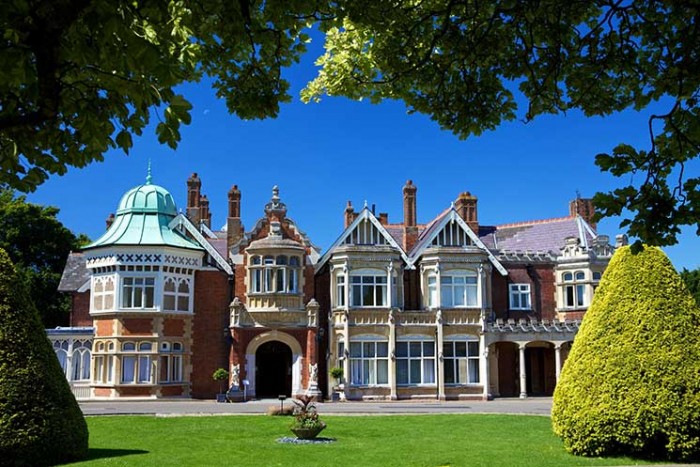5 places to explore Britain’s industrial heritage
Britain is famous for its royal history, castles and landscapes, but it was also at the forefront of Industrial Revolution, giving birth to the modern world. A new book The Geek’s Guide to Britain takes a close look at where the country’s inventiveness, creativity and technical wizardry can still be seen. Here, we pick five of the most fascinating places to visit
Bletchley Park, Bletchley, Milton Keynes
Bletchley Park is well-known as the central site for Britain’s codebreakers during the Second World World, including the most famous, Alan Turing. Lesser-known is that it was staffed by an army of 12,000 working in shifts around the clock and two thirds of the staff were women, many of whom were “Wrens” or Women of the Royal Naval Services.
The cracking of the German military’s Enigma code by Turing and his team is one of Bletchley Park’s most famous achievements: Once cracked, Bletchley sifted through more than 20,000 Axis messages each day to reveal such crucial details as German air force deployments during the legendary Battle of Britain and the location of the killer battleship the Bismarck, sunk through a massive Royal Navy operation. Bletchley housed the first computers ever to hack crypto – the Tunny and Colossus.
Entry: Winter opening – 1 November to 28 February, 9.30am to 4pm, summer opening – 1 March to 31 October, 9.30am to 5pm
Entry fee: Adults £16.75, children 12-16 £10, under-12s go free, family tickets £38.50.
Falkirk Wheel, Tamfourhill, Falkirk
When is a wheel not a wheel? When it’s a lift. The Falkirk Wheel can lift six canal boats 25 metres in one go, moving them from one waterway to another.
The Forth & Clyde Canal, running across central Scotland, used to be connected to the Union Canal, linking Glasgow to Edinburgh via a stairway of 11 locks. This was closed in 1938 and a Millennium Project to reconnect the canals needed something spectacular to go in their place. This arrived in 2002, in the form of the huge Falkirk Wheel (114.8ft / 35m across) – a steel and concrete structure that contains 15,000 hand-tightened bolts. Watching it you can’t help but be reminded of some Victorian flight of fancy as it slowly revolves to deliver the 300-ton, perfectly balanced gondolas.
Entry: Admission is free and parking on site costs £2 for the day. Boat trips cost £8.95 per adult, £7.95 for concessions and £4.95 per child. The visitor centre and café is open every day from 10am to 5.30pm.
Brunel Museum, Rotherhithe, London
The Brunel Museum is a celebration of the Brunel family – Isambard Kingdom Brunel, his father Marc Isambard Brunel, and son Henry Marc Brunel. Their creations can be found across the UK – including the Clifton Suspension Bridge and a network of tunnels, bridges and viaducts for the Great Western Railway.
The museum itself, however, is on the spot where Marc employed new tunnelling methods to span the River Thames for underground foot transport for the first time at Rotherhithe, a project where workers braved death by drowning or poisoning each day. It was a landmark feat with the Engine House – home to the museum – built in 1842. The tunnel not only wowed early Victorians it helped expand the London further to the East.
The underground chamber was opened to the public in 2010, 150 years after it was closed off by the London transportation system.
Entry: Open seven days a week 10am to 5pm. Adults £3, £1.50 for concessions and free for children under 16. There are also boat and walking tours.
James Clerk Maxwell’s House, Edinburgh
Many believe radio was invented by Guglielmo Marconi, the Italian emigrant whose work on the transatlantic radio transmissions helped turn wireless into a defining medium of the early 20th century.
But radio waves were theorised and discovered by another max, James Clerk Maxwell – an individual essential to physics as we understand it today. But Maxwell’s contributions are not confined simply to radio: his theories on the rings of Saturn were borne out of 20th-century science, he produced the first colour photo, and he founded and helped build Cambridge University’s Cavendish Laboratory in 1879.
Maxwell’s House belongs to the James Clerk Maxwell Foundation.
There is no charge for viewing the house, but an appointment must be made with the James Clerk Maxwell Foundation.
de Havilland Museum, Hertfordshire
Britain’s aircraft industry has produced many iconic names – the Spitfire, Hurricane, Lancaster Bomber. The de Havilland Museum celebrates yet one more: the twin-engine DH.98 Mosquito multi-role Second World War craft nicknamed the Wooden Wonder and produced by Geoffrey de Havilland. This was one of the Allies’ few aircraft capable of matching the speed of Hitler’s first rocket bombs, the V1.
The Mosquito airframe was the first specimen to be landed by this museum, which was built entirely from scratch by enthusiasts. Since then their museum has gone on to track the whole history of the 44-year de Havilland company and its iconic craft.
Entry: Open from the first Sunday of March to the last Sunday of October on Tuesdays, Thursdays, Fridays, Saturdays, Sundays and Bank holidays. Cost of entry is £8 for adults, £7 for concessions and £5 for children aged 5-16.




